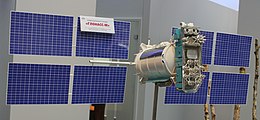 Model of Glonass-M satellite at CeBIT 2011. | |||
| Designer | ISS Reshetnev | ||
|---|---|---|---|
| Country of origin | Russia | ||
| Operator | JSC «Navigation-Information Systems» | ||
| Applications | Navigation | ||
| Specifications | |||
| Bus | 3-Axis stabilized Uragan-M[2] | ||
| Constellation | GLONASS | ||
| Launch mass | 1,415 kg (3,120 lb)[1] | ||
| Power | 1250 W[1] | ||
| Batteries | NiH2[3] | ||
| Equipment | 3 Cs clocks[3] FDMA signals: L1OF, L1SF, L2OF and L2SF CDMA signals: L3OC (s/n 755+) Space Laser Ranging[3] | ||
| Regime | MEO | ||
| Design life | 7 years[1] | ||
| Production | |||
| Built | 51 | ||
| Launched | 51 | ||
| Operational | 21 | ||
| Retired | 24 | ||
| Lost | 6 | ||
| Maiden launch | 10 December 2003 (Kosmos 2404) | ||
| Last launch | 28 November 2022 (Kosmos 2564) | ||
| Last retirement | 3 December 2022 (Kosmos 2464) | ||
| Related spacecraft | |||
| Derived from | GLONASS | ||
| |||
GLONASS-M (Russian: ГЛОНАСС-М), also known as Uragan-M (Russian: Ураган-М) (GRAU index 11F654M given to the first two pilot satellites and 14F113 to the rest) are the second generation of Uragan satellite design used as part of the Russian GLONASS radio-based satellite navigation system. Developed by ISS Reshetnev (Information Satellite Systems Reshetnev), it had its debut launch in 2003, and is in the process of being phased out. Its production finished in 2015 and its last launch was in November 2022. It is an evolution of the previous Uragan (GRAU Index 11F654) second-generation satellites, improving accuracy, increasing power, extending the design life and adding the FDMA L2OF open signal. The last eight Glonass-M spacecraft in production included the new CDMA L3OC open signal.
- ^ a b c d Cite error: The named reference
testoyedov-2015was invoked but never defined (see the help page). - ^ Cite error: The named reference
gunter-uraganmwas invoked but never defined (see the help page). - ^ a b c Cite error: The named reference
issr-20121109was invoked but never defined (see the help page).